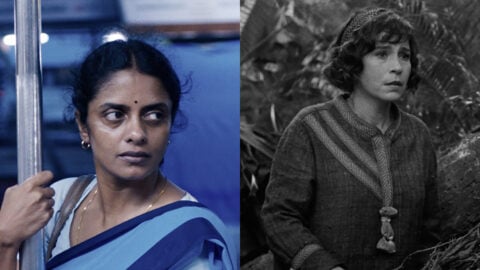Present Tense: Female Comedians
Present Tense is a column by Sheila O’Malley that reflects on the intersections of film, literature, art, and culture.
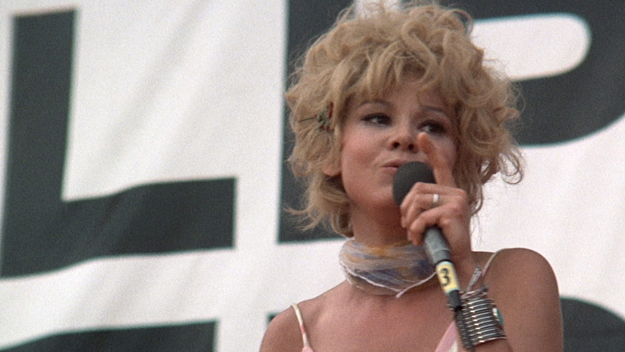
Barbara Harris in Nashville (Robert Altman, 1975)
To start, two moments from Robert Altman’s Nashville:
- Gospel singer Linnea Reese (Lily Tomlin) stands in her dining room, listening to her two deaf children tell her about their day. She signs her responses, and is completely present with them, listening with her whole spirit and soul. This takes some doing, since her husband (Ned Beatty) stands nearby, barely tolerating his children’s disabilities. Linnea Reese is full of surprises, many of which unfold after this scene, but it’s a crucial moment, and Tomlin’s quiet centered focus on the children tells us everything we need to know about the character.
- Albuquerque (Barbara Harris), an aspiring country-western singer, haunts the periphery, a ragged urchin figure wandering through Nashville in ripped hose, hoping for a break. When her chance arrives (albeit in the wake of an assassination), she’s ready. Altman closes the film with Albuquerque’s triumph, singing “It Don’t Worry Me” to a traumatized crowd. Her triumph is not smooth and Harris goes through all kinds of transformations during her performance of the song, starting shakily, building in confidence, tossing flowers back into the crowd with insouciant ease. Albuquerque expands to the size of the stage she’s on.
Both actresses—Harris and Tomlin—came from an improv and/or comedy background. Harris was on the forefront of the new improv “scene” in the late 1950s, first with The Compass Players (a groundbreaking improv troupe), and then with the brand new Second City company. Tomlin had a successful stand-up act, and then was cast on the variety show Laugh-In, which made her famous. Robert Altman was no dummy. If you want an actor to elevate a project beyond the “serious” (because “serious” is too limiting), if you want an actor who can tap into something epic and archetypal … those who “come from comedy” may be your best bet. There was a lot of surprised chatter at the time about how good Tomlin was in a serious role. There should be no surprise. Tomlin is a “clown,” whose characters like Ernestine the telephone operator or 5-year-old Edith Ann are still high watermarks of that kind of transformational work. Watch Nashville and The Seduction of Joe Tynan back to back and tell me that Barbara Harris couldn’t play anything.
Why comedy and improv often produce some of the greatest actors (although they rarely get the “props” that so-called “serious” actors do) is one of my ongoing obsessions, in particular when it comes to actresses. Actresses who come from, specifically, an improv background, bring something to the table that other actors don’t. (There’s a reason so many acting teachers I know suggest their students take improv classes.) People like Tomlin, Harris, Kristen Wiig, Melissa McCarthy, Catherine O’Hara… their transformations go way beyond putting on a prosthetic nose. Humphrey Bogart once said good acting was six feet back in the eyes. These actors go deeper.
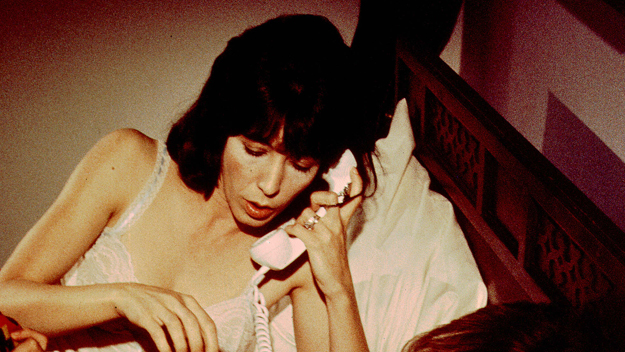
Lily Tomlin in Nashville (Robert Altman, 1975)
When living in Chicago in the ’90s, Friday and Saturday night shows at Improv Olympic were the equivalent to appointment television. The flagship improv team at that time was The Family, an all-male group consisting of Adam McKay, Neil Flynn, Matt Besser (who eventually co-founded the improv company Upright Citizens Brigade with Amy Poehler), Ali Farahnakian, Ian Roberts, and Miles Stroth, all of whom have gone on to great success. The team had studied with guru Del Close, and their shows were so legendary people still talk about them. (There were many other great teams at the time, including the “Armando Diaz Experience,” a group improv show still up and running.) I asked Miles Stroth once about how “straight” acting might differ from improv, and he said it didn’t, not really. “Acting is like slow improv,” he said.
Improv is fast. There’s no time to second-guess your choices. Improv requires openness to your scene partner. Improv has very specific rules, the most famous being “Yes, and…” To boil down “Yes, and… ”, it means accepting what the other person gives you in the scene, and then adding to it. If someone starts a scene by pointing a “gun” at you, you can’t respond with, “That’s not a gun, that’s your finger.” Or, you can, you may even get a laugh, but you’ve killed the scene. In improv, you don’t try to “nail” the moment. You live within the moment. The moment is all there is. The other thing improv teaches, like no other tool, is the importance of listening. Without listening, nothing is possible. Bill Murray during his time performing at Second City would hang back on the edge of a scene, watching, absorbing what his teammates were doing, waiting for his “Yes, and…” moment. When he stepped into a scene, he would often make one simple comment that “summed up” or “completed” the event of the scene, and the audience would fall apart. This is three-dimensional—maybe even four-dimensional—listening.
Comedy is “entertainment,” sure, but it’s also better equipped to bring an audience together in ways not just funny but cathartic. Physicist Niels Bohr—not really known for being a laugh-riot— said once, “Some subjects are so serious that one can only joke about them.” Comedians understand this. Clowns understand this. There’s a moment in Laugh, Clown Laugh (1928) when Lon Chaney, as the clown Tito, in love with tightrope-walker Simonetta (Loretta Young), collapses in a chair, his bulk of a body deflated like a balloon. He flings up one hand over his eyes, his other hand clutching at his throat. His mouth hangs slack. It’s devastating, a portrait of such anguish it moves beyond an “acting moment” and into something else, an archetype of an emotional state, the Platonic Ideal of what great pantomime can be, what it used to be in the hands of its best practitioners, the tradition developed in the millennia before cinema and the closeup changed the game. Chaney played clowns and “grotesques,” but was also one of the great tragic actors. Remember this when someone expresses surprise at how good a comedian is in a serious role.
In preparing this essay, I reached out to my friend Mitchell Fain (also responsible for the term “back-ting,” the focus of another column). Fain has been working in the circus for almost two decades, and has a longtime gig with the Midnight Circus, put on in Chicago every autumn. I asked him for any insights he might have about clowning. He responded:
“You know what clowns do? They reflect our humanity back at us in an exaggerated way. I’m not talking about Ringling Brothers clowning with red noses and rainbow wigs, although this has its place, which is pure liquid silliness. I’m talking about clowning in the European tradition, the commedia tradition. One finds one’s clown character by excavating something real and then exaggerating it so that we can then have compassion and empathy. I really believe clowning is about empathy and reflecting us back to each other. I could make a very scholarly argument for why RuPaul’s Drag Race is the best show on TV, and part of it is that drag is gay clowning. It’s taking some element of a personality and exaggerating it, and then through that exaggeration we experience laughter, joy, empathy, sadness, compassion. That, to me, is what real clowning does.”
Adam Kuchler, a clown in the Midnight Circus, as well as head clown at the Big Apple Circus, had this to add to my query: “Great clowning is allowing the id without the interference of the ego.” I can’t stop thinking about these comments.
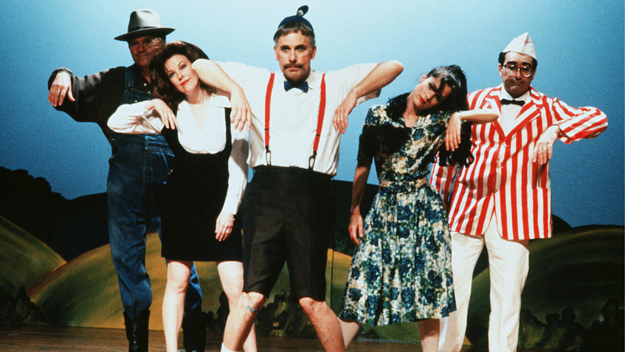
Waiting For Guffman (Christopher Guest, 1998)
I think of Catherine O’Hara in Waiting for Guffman, the tragedy of her character bristling in her spritzed bangs, in the look of wild despair floating behind her wide smile. The performance is so hilarious, but it also reveals something painful and true. To quote Kuchler, O’Hara works in a place of “id” and her “ego” does not interfere. In Heartburn, she nearly steals a scene right out from under Meryl Streep. (It is my belief that Meryl Streep’s true gift lies in comedy. Or, to put a better way: her uncanny gift for comedy is the reason why her famous transformations in serious material are so dazzling. It’s no different from Tomlin’s various transformations on Laugh-In. Again: Altman is no dummy. He put Tomlin and Streep together in Prairie Home Companion and it was a match made in heaven.) In a deleted scene in Waiting for Guffman, Fred Willard is being “interviewed,” and O’Hara stands off at the edge of the yard, staring at the field beyond. Her back is to the camera. (Talk about “back-ting.”) She’s the only thing you look at. The moment is outrageously funny, but her desire to run across that field—never to return—vibrates off her back.
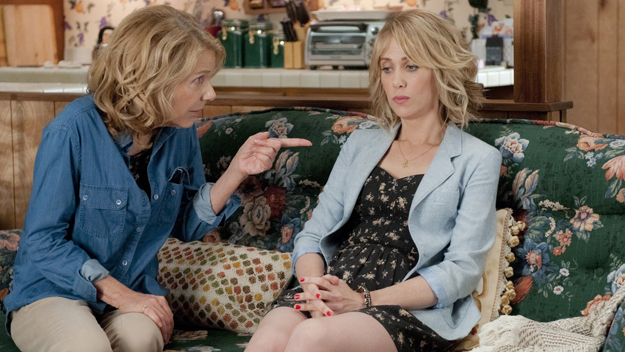
Jill Clayburgh, Kristen Wiig in Bridesmaids (Paul Feig, 2011)
Kristen Wiig’s performance in Bridesmaids is, of course, very funny, but the humor comes out of her understanding of—and compassion for—the character’s sadness, and how obnoxious sad people can be. Wiig’s reaction to the news that her best friend (Maya Rudolph) is engaged is a brilliant piece of acting. She starts laughing joyfully, and then murmurs “My stomach hurts”, all while flipping the neck of her shirt around to air herself out. She’s having a nervous breakdown. When she’s left alone, she starts laughing and can’t stop. Her eyes are pin-wheels of panic. The moment appears to be happening to her. Wiig is not manipulating it (or, the manipulation is invisible). Watch Wiig in Bridesmaids and then watch Hateship Loveship, Welcome to Me, and Skeleton Twins in succession. Each character is so distinct it’s like Wiig swaps out her soul for each role. (The last three films all came out in 2014, and the fact that Wiig didn’t get more accolades for these transformations—none of which involved radical shifts in appearance or self-congratulatory weight-loss/gain—is evidence of how actors known for comedy aren’t taken as seriously as their dramatic counterparts). Throw in Wiig’s lunatic Saturday Night Live sketch “Liza Minnelli Turns Off a Lamp” to get the full picture of her gift. I think Wiig is one of the best actresses working today.
It’s not a surprise that one of the acting moments of 2019 for me comes from SCTV improv veteran Andrea Martin, in Kent Jones’s Diane. Martin sits across from Mary Kay Place at a restaurant, listening to her friend complain. Martin is sympathetic, but she’s heard these complaints a million times. Martin has a long silent moment, where she has so much to say to her friend … and then chooses, after some struggle, not to speak. In one long pause, you see the whole backstory—not only of her character, but of the friendship. The best word for Martin’s work in that moment is accurate. Accurate and deep as the Mariana Trench. It’s the essence of great acting.
Sheila O’Malley is a regular film critic for Rogerebert.com and other outlets including The Criterion Collection. Her blog is The Sheila Variations.



